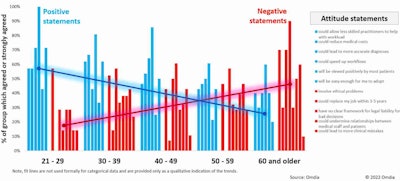
The potential of medical imaging artificial intelligence (AI) is widely acknowledged to be game-changing. For example, there is a large body of studies that have reported levels of diagnostic accuracy for AI that exceed that of human experts.
However, as of 2022, medical imaging AI is rarely used in clinical practice. There are several factors that explain this slow rollout, including regulatory barriers, development costs, and the ongoing use of old imaging systems.
One additional issue is the attitudes toward medical AI within the professionals who would be using it. This is an important issue because these attitudes may strongly affect the speed of adoption. Hostility could lead to slow adoption of AI and vice versa. Despite the importance of this question, there is a gap in the scientific literature.
Anecdotally, however, many imaging professionals think that imaging AI is being overhyped. Still others believe that there are dangers with imaging AI that are being ignored.
But anecdotes are one thing. What data are there?
To address this gap in the literature, Omdia developed a survey to measure attitudes among imaging professionals in collaboration with the British Medical Ultrasound Society. Here are some of the highlights of this research.
1. Most imaging professionals have not used imaging AI
A slight majority of respondents (52%) indicated that they had not used imaging AI and 28% stated that they had. A sizeable proportion (20%), however, were not sure.
This 20% is an interesting statistic and could be interpreted in different ways. It could be seen as a measure of a general uncertainty about what imaging AI is. Alternatively, it could reflect that in many cases algorithm developers are not making it clear that AI-based software is already deployed.
This could be understandable, as imaging professionals may be more interested in what the software achieves (e.g., which kinds of physiological measurement) than how it works, i.e., whether or not it is "AI-based."
2. Overall attitudes to imaging AI were mixed, but generally positive
Attitudes to medical imaging were generally positive. This is based on the observation that respondents gave positive overall responses to five statements on medical imaging AI and negative responses to only two.
Importantly, the positive attitudes were for applications of medical imaging AI of most significance for public health, including reducing medical costs and the potential for more accurate diagnoses.
The negative attitudes were on the absence of a clear framework for legal liability and the existence of ethical issues. What ethical issues might these be? It was beyond the scope of this study to investigate this but one of the most discussed in recent years is potential bias based on, for example, race and sex/gender.
3. Attitudes to medical AI by age
There was clear evidence in responses to the Omdia survey that overall attitudes to medical AI became less positive with increasing age. This was a strong effect.
This finding is consistent with a wealth of evidence that technology use is related to age. We sometimes speak about a "digital divide," with older adults tending to use digital technology less than younger people. Alternatively, these results may reflect the inclusion of AI in the more recent training programs of radiographers and radiologists.

4. Attitudes were more positive among those who had previous use of medical AI
Attitudes to medical imaging AI were strongly related to previous use. Respondents with previous experience of AI tended to have more positive attitudes.
What explains this? It could be that experience of medical imaging AI leads to more positive attitudes. But it is also possible that people with already positive attitudes tend to seek out experience of medical imaging AI. Thus, there are two distinct directions of causation that could underlie these results.
However, the two possibilities are compatible, and it is likely that both have some explanatory power. In any case, these results suggest that the rollout of medical imaging AI may encounter diminishing resistance over time, as practitioners of medical imaging gain more experience.
Conclusions
Overall, the results of the Omdia survey give a positive indication about the potential level of acceptance of medical imaging AI within medical imaging professionals. Further, the specific positive attitudes were on the most important aspects of medical AI: cost-savings and greater diagnostic accuracy. However, our results also highlight concerns, particularly surrounding ethics and legal liability issues.
Felix Beacher heads the Health Care Technology team at Omdia/Informa. He has a PhD in clinical neuroscience from King's College London and has authored several journal papers and book chapters in neurology and cancer. He recently was the lead author on the world's first paper on AI for predicting clinical trial outcomes, a conceptual breakthrough for precision medicine. He can be reached at [email protected].
The comments and observations expressed are those of the authors and do not necessarily reflect the opinions of AuntMinnie.com.



















